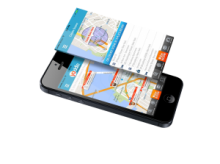5 Best Practices For Compelling Mobile Apps
Submitted by Heather Clancy on

3. Launch and iterate quickly
How many times per month are some of your favorite mobile apps updated? Historically speaking, the philosophy behind many enterprise engagement is to get things "right" before rolling out new technologies.
Delivering mobile apps, however, turns that process upside down, notes Ashish Toshniwal, CEO and founder of Y Media Labs, a 100-plus-person company that has handled projects for the likes of Safeway, eBay and Le Meridien. "I'm a big fan of launching fast, understanding what users are looking for, and then pruning the roadmap from there," he said.
One of the practices that effective mobile apps developers will help customers avoid is attempting to replicate all of the existing features on a Web site or in an enterprise application on a mobile device, Toshniwal noted. A better idea is to pick one or two processes that need to be handled well, and then build out from there quickly. "No matter how much you think or speculate, you won't be right all the time," he said.
4. Prioritize testing, ongoing evolution
The need for frequent updates will open the door to managed services opportunities related to mobile apps, not just to add new features but also to ensure that a specific offering stays in lock-step with new mobile operating system releases.
App Partner offers this sort of support behind the scenes, checking on an ongoing basis to ensure that the cloud infrastructure serving up its clients' mobile apps is reliable over time. It also provides customers with analysis of usage trends, with an eye toward providing insights that might be used to add future features. "Optimization is the word we use," Johnson said.
For the solution provider, that means being careful about how many hours of time are built into a development contract and specifying how often the code will be (or should be) updated.
5. Don't shortcut interface design
As with any technology driven mainly by consumer adoption trends, the only thing that technology solution providers really can't afford to scrimp on is creating an elegant, simple user interface for every mobile application they develop. Does it take one swipe of the finger or gesture to complete a task or three or four? What corporate users might tolerate within a desktop application won't fare well within a mobile environment.
"When you think enterprise apps, you think big, heavy, clunky," Toshniwal said. "Even when you're working with big data, at the end of the day, an enterprise customer is also a consumer. There is no reason that these apps should not be delightful."
Image of Yoddle app courtesy of App Partner






